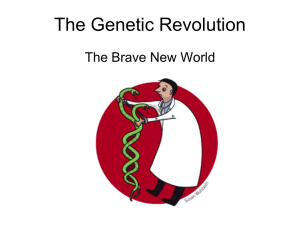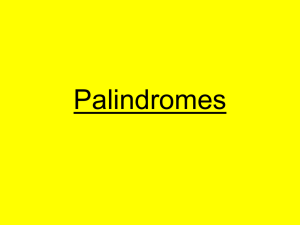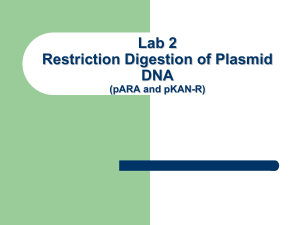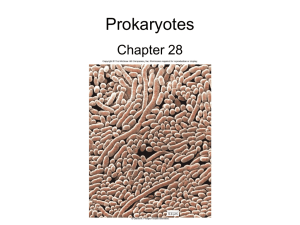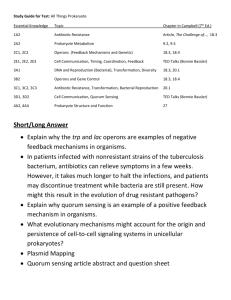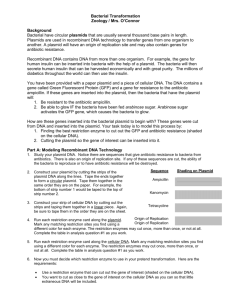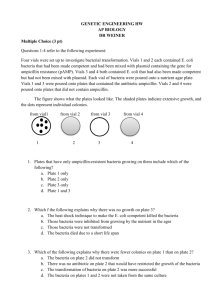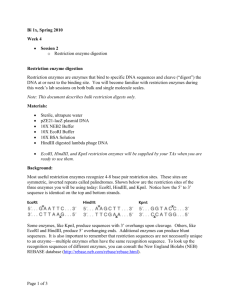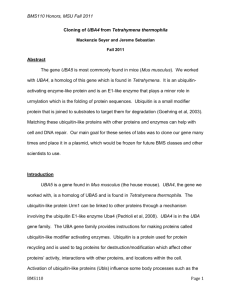Unit 4 Notes for pGlo lab
advertisement
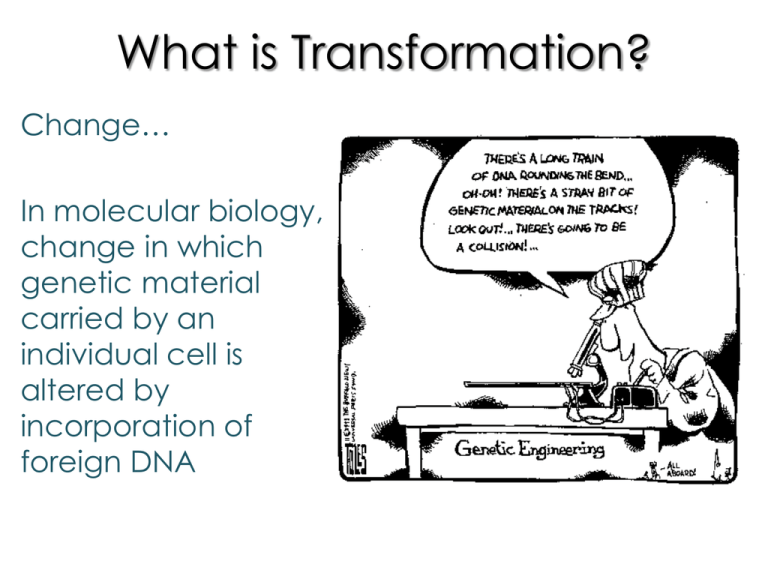
What is Transformation? Change… In molecular biology, change in which genetic material carried by an individual cell is altered by incorporation of foreign DNA Objective 1 - Define the term plasmid and explain its significance for bacteria and recombinant technology. • A plasmid is a small piece of circular DNA in bacteria in addition to bacterial chromosome • Typically contain genes for traits beneficial for survival such as antibiotic resistance • In nature, bacteria transfer these plasmids back and forth • Acts as a vector – a gene taxi to get new DNA into bacteria Constructing a Plasmid • Specific fragments of DNA may be isolated, cut into discrete pieces by the action of restriction enzymes, and rejoined by the action of DNA ligase http://www.dnai.org/b/index.html Objective 2 - Describe how genomic and plasmid DNA can be isolated from cells. How is DNA isolated? http://www.iupui.edu/~wellsctr/MMIA/is olating_dna/dna_isolation_rev.swf Objective 3 - Explain how the creation of sticky ends by restriction enzymes is useful in producing a recombinant DNA molecule. Also called restriction endonucleases 1962: “molecular scissors” discovered in in bacteria E. coli bacteria have an enzymatic immune system that recognizes and destroys foreign DNA 3,000 enzymes have been identified, around 200 have unique properties, many are purified and available commercially Restriction Endonucleases Recognition sites have symmetry (palindromic) “Able was I, ere, I saw Elba” 5’-GGATCC-3’ Bam H1 site: 3’-CCTAGG-5’ Restriction Enzymes Enzymes recognize specific 4-8 bp sequences Some enzymes cut in a staggered fashion - “sticky ends” EcoRI 5’…GAATTC…3’ 3’…CTTAAG…5’ Some enzymes cut in a direct fashion – “blunt ends” PvuII 5’…CAGCTG…3’ 3’…GTCGAC…5’ Why don’t bacteria destroy their own DNA with their restriction enzymes? Methylation!! Why are sticky ends better? • The most useful restriction enzymes cut DNA in a staggered way, producing fragments with “sticky ends” that bond with complementary sticky ends of other fragments. • Blunt ends do not have the “overlap” to bond with. Sticky end restriction enzymes in transformation Human DNA cleaved with EcoRI 5’-C-G-G-T-A-C-T-A-G-OH 3’-G-C-C-A-T-G-A-T-C-T-T-A-A-PO4 Corn DNA cleaved with EcoRI + PO4-A-A-T-T-C-A-G-C-T-A-C-G-3’ HO-G-T-C-G-A-T-G-C-5’ Complementary base pairing 5’-A-C-G-G-T-A-C-T-A-G A-A-T-T-C-A-G-C-T-A-C-G-3’ 3’-T-G-C-C-A-T-G-A-T-C-T-T-A-A G-T-C-G-A-T-G-C-5’ + DNA Ligase, + rATP 5’-A-C-G-G-T-A-C-T-A-G-A-A-T-T-C-A-G-C-T-A-C-G-3’ 3’-T-G-C-C-A-T-G-A-T-C-T-T-A-A-G-T-C-G-A-T-G-C-5’ recombinant DNA molecule Restriction enzyme animation http://www.dnai.org/b/index.html Go to Techniques – cutting and pasting Objective 4 - Explain each of the steps taken to isolate a gene of interest and insert it into bacterial DNA to produce the desired protein. Recombinant Plasmid E. coli host cell Transformed Bacteria http://www.sumanasinc.com/webcontent/animations/content/plasmidcloning.html Making bacterial clones The genomic DNA and a bacterial plasmid are isolated Both are digested with the same restriction enzyme The fragments are mixed, and DNA ligase is added to bond the fragment sticky ends The solution with the transformed plasmid is added to bacteria. Bacteria take up plasmid Bacteria are grown in culture dishes, creating “clones” that should all have the plasmid in them But how do we check? Objective 5 - Identify ways to determine if genetic transformation has been successful. A clone carrying the gene of interest can be identified with a nucleic acid probe having a sequence complementary to the gene The plasmid may also incorporate an ampicillin resistance gene, then the bacteria grown in the presence of ampicillin, only the bacteria with the plasmid of interest should survive. A gene for fluorescent protein may be incorporated into the plasmid with the gene of interest, showing which organisms now carry the gene of interest Ampicillin Resistance Gene Bioluminescence Gene pGreen Plasmid Bioluminescent AND antibiotic resistant Objective 6 - Describe how newly formed protein is isolated from transformed bacterial cells. • Wash cells from plates and centrifuge, discard liquid • Lyse bacterial cells in a non-denaturing environment (protease inhibitors and buffer solution) • Centrifuge and collect the liquid for soluble proteins and the pellet for non soluble protein • Check with gel electrophoresis Objective 7 - Relate bacterial transformation to real life applications used by society. • Insulin • Growth hormone • Interferon Information from (among others) microvet.arizona.edu/Courses/MIC205/10GenEng/GeneticEng Ineering and www.udel.edu/chem/bahnson/chem527


